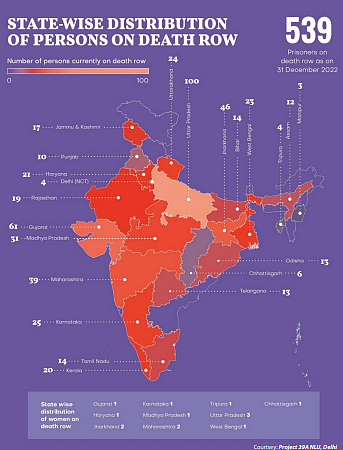The Death Row Obsession
Why is the death sentence so popular in India when it doesn’t even deter crime?

Of the 110 death penalty cases that reached the Supreme Court between 2016 and 2022, the Court upheld ‘under 4 per cent’, reveals the latest annual edition of ‘Death Penalty in India: Annual Statistics Report’, published by Project 39A at the National Law University, Delhi.
At the end of 2022, there were 539 Indians on death row, a 40 per cent jump since 2015, and the lower courts sentenced 166 accused to death, the highest in a single year since the turn of the century.
While there is strong support for the death penalty among the people, and India was among the 37 countries that opposed a UN resolution in December 2022 seeking a moratorium on the death penalty (125 countries supported the resolution), there is no evidence that it is an effective deterrent. For example, more than half the death sentences pronounced by trial courts in 2022 were for sexual violence, including 47 for rape and murder, but there has been no decline in this crime, with the National Crime Records Bureau (NCRB) recording an average 30,000 or so reported cases of rape every year.
According to government data, between 2019 and 2021, more than 92,000 women and minor girls—more than 30,700 on average every year—were victims of rape.
A handful of states (see graphic: Leading the Charge) have been notably unsparing in awarding the death penalty, but with no real improvement in their law-and-order situation.
In 1980, the Supreme Court of India had upheld the Constitutional validity of the death penalty. But the court had also cautioned that judges must weigh both ‘aggravating factors’ and ‘mitigating factors’ that may suggest harsher or lighter punishment. Death sentences could not be based only on the nature of the crime.
However, in 2022, says the report, 98.3 per cent of death sentences were awarded without the courts reviewing any material on mitigating circumstances. In none of these cases did the state produce material or evidence on the question of the possibility of ‘reform’, which had been laid down as a guideline by the apex court in 1980.

With a large number of prisoners on death row being uneducated or poor or both, their inability to defend themselves and afford quality legal representation is easy to surmise.
Thus, failing to exercise caution and bring balance to their cases also exhibits the indifference, if not ignorance, of both the bar and the bench, as well as a degree of callousness on the part of the State.
For the first time since 1980, however, the Supreme Court recognised in 2022 the need to reconsider the framework involved in awarding capital punishment and referred the question to a Constitution bench. It also laid down guidelines for the collection of mitigating material by trial courts. The court also emphasised that it was the duty of the trial courts to explicitly ask for material on mitigating circumstances.
Project 39A at the NLU estimates that India has executed 720 people since Independence, with Uttar Pradesh accounting for half the number. Haryana has 90 to its name and Madhya Pradesh 73. Between 1991 and 2000, a total of 15 prisoners on death row were executed, but thereafter only four in the next 20 years—until four men convicted for the gang rape of Nirbhaya (2012) were hanged in March 2020.
Figures of similar executions in China are not available, though it is alleged that thousands are executed every year.
And while 20 states in the US have abolished the death penalty, many still get executed there. Amnesty International, which campaigns against the death penalty, claimed that in 2018 nearly 80 per cent of all recorded executions took place in just four countries—Iran, Saudi Arabia, Vietnam and Iraq.
Follow us on: Facebook, Twitter, Google News, Instagram
Join our official telegram channel (@nationalherald) and stay updated with the latest headlines
